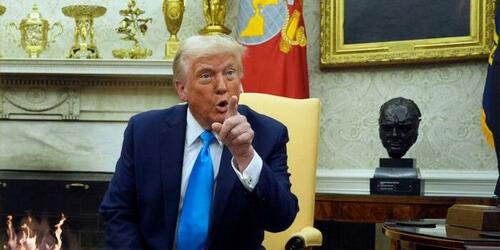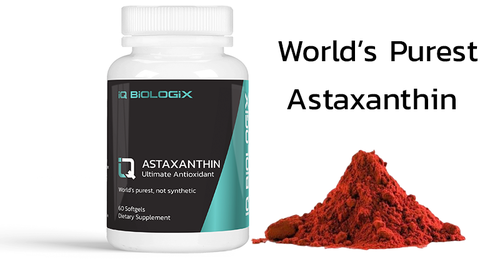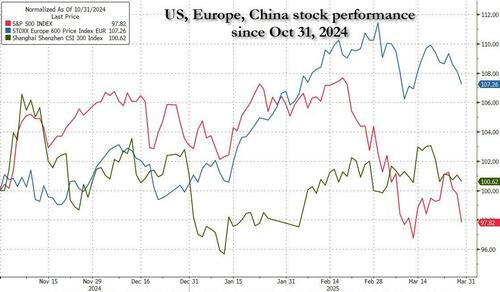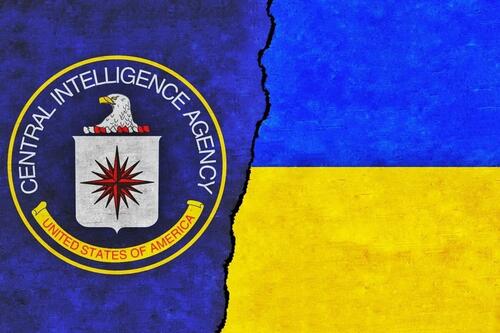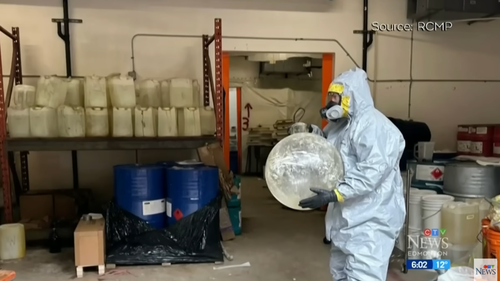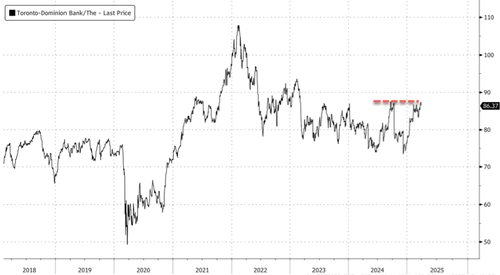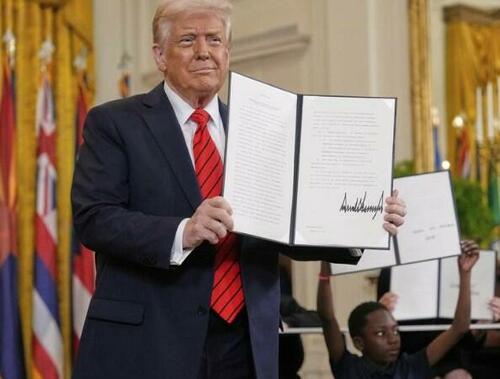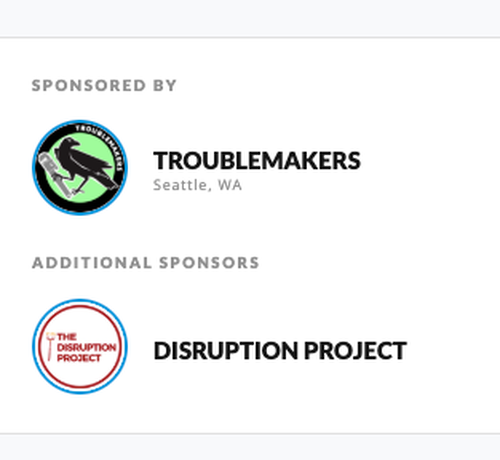In an explosive, sweeping interview, former senior State Department investigator David Asher—closely connected to the Trump administration's financial and national security apparatus—warned that Canadian banks could soon face a "new universe" of regulatory scrutiny, including from the U.S. Treasury, due to the recent designation of Mexican cartels as foreign terrorist organizations.
Asher, who contends that the "command" for Western Hemisphere money laundering of synthetic narcotics—including fentanyl, methamphetamine, and ecstasy sourced from Chinese precursors—is "largely run by Chinese triads in Canada," also argues that this interconnected transnational network presents profound risks to Canadian financial institutions.
Speaking bluntly about the nexus between Chinese Triads and Mexican cartels operating in Canada, Asher said: "Of course, they're in bed with each other. This is why Tse Chi Lop lived in Toronto… These cartels are now designated as terrorist organizations. That changes everything—how we prosecute them, and what tools we can use."
Asher, along with Canadian law enforcement experts such as former RCMP intelligence analyst Scott McGregor, believes a rarely discussed Canadian legal barrier—Stinchcombe—must be overcome. They argue Canada could unlock powerful new authorities if it begins treating cartel-connected Chinese money laundering networks as accessories to terrorism.
The rule, derived from the 1991 Supreme Court case R. v. Stinchcombe, requires Canadian law enforcement to disclose nearly all investigative material to the defense. While intended to ensure a fair trial, critics say it severely hampers complex RCMP investigations, especially those relying on wiretaps or sensitive intelligence, and risks blowing the cover of international partners and covert operations.
Asher didn't mince words: "Every case I worked in Canada… the Stinchcombe thing ended up [inhibiting investigations]—we were targeting phone numbers tied to Canadian money launderers who were Chinese. And they got told after 90 days that we were going after them. Then they just changed numbers and changed their OPSEC. It's a farce."
He sees the recent terrorism designation of Mexican cartels as a legal pivot point: "That whole Stinchcombe thing should be thrown out the door because we can now use counter-terrorism authorities."
Asher believes that if Canadian law enforcement engages more directly with U.S. authorities, the financiers and money launderers tied to Chinese triads in Canada can be directly linked to fentanyl-trafficking Mexican cartels. If Canadian banks are shown to be facilitating these funds, even passively, they may be subject to U.S. regulations—including terrorism finance sanctions.
The implications for Canadian institutions are profound. "If any of these financial institutions are picking up a dollar for the cartels at this stage and we can prove it, then they're engaged in terrorism financing."
Asher also pointed to marijuana trafficking from Canada into the United States—not as a separate criminal enterprise, but as part of the same transnational fentanyl networks. He said Chinese Triads, with ties to the Chinese Communist Party, sit atop this narcotics pyramid and are exploiting Canada's legal marijuana system.
"The illegal pot—marijuana from Canada that comes into the New York State tri-state area and into the Pacific Northwest states of the United States is huge. And now we're seeing the integration of fentanyl into marijuana in some cases."
The flow of narcotics south and criminal proceeds north continues largely unabated, Asher warned, with superlabs in British Columbia and other areas of Canada producing meth, ecstasy, and fentanyl.
On Canada's enforcement efforts and the outcomes of official inquiries into Chinese criminal and influence networks, Asher was scathing: "What have you done to follow up on [the Cullen Commission]? Nothing. And then you had this Hogue inquiry about Chinese influence in politics. What have you done about that? It looks to me like practically nothing."
He called on Canada to show resolve on investigations that impact the United States: "Frankly, one of the first things you still need to do is: why is TD Bank Canada not being charged? And do we have charges against some of the executives, whether they've been publicly named or not?"
His core message is that Canada must shake off legal and political inertia: "Why wouldn't Canada want to protect itself? You're losing thousands of people every year, sometimes tens of thousands, due to overdoses and poisonings and basically murder in the form of these narcotics networks."
The consequences of inaction, Asher warned, could be dire—not only for Canadian sovereignty and public health, but for its banking sector's international standing. "Canadian money laundering command and control remains a huge issue for drug trafficking across the United States… That's just the bottom line."
The following transcript has been edited for clarity and brevity. Some passages have been removed to streamline the discussion while preserving its core insights.
Sam Cooper: What is the key change that designating the Sinaloa cartel and these other Mexican cartels as terrorist networks—because Canada followed President Trump on that. So now this anti-terrorism law should be applicable in Canada. One, does that change the calculus of the U.S. working with the Canadian government in going after cartels in Toronto, Vancouver, and Montreal? And two, in your view, are these cartels operative with Chinese command-and-control financiers that underwrite their operations across North America?
David Asher: First of all, of course, they're in bed with each other. I mean, this is the reason why Tse Chi Lop lived in Canada and in Toronto. I mean, the Sinaloa cartel has significant operations with partners and proxies in Canada, both for distribution and, increasingly, we believe with production—the rise of these super labs.
And so, the way I define it: we can do law enforcement top down. We use their intelligence, use their sources. We know who the leadership are, we know where the money is. Rather than build a case from the bottom up and start with dime bags on the streets of Chicago or Vancouver, we say we know these cartels are designated, and now these cartels are terrorist organizations. That changes everything in terms of how we could prosecute them and what type of tools we can use. Because that whole Stinchcombe thing should be thrown out the door because we can now use counter-terrorism authorities. Because Canada does have a reasonably strong counter-terrorism law.
So if we treat these cartels as terrorists—which they are—and you've designated them, we can use our signals intelligence and all sorts of other tools to much more robustly target them without them knowing it. Because every case I worked in Canada, the Stinchcombe thing ended up—we were targeting phone numbers tied to Canadian money launderers who were Chinese, and also actually some Italian mob guys too, and Iranian mob guys. And they got told after 90 days that we were going after them. And then they just changed numbers and they changed their OPSEC. It's a farce, you know that. But I mean, just like with the terrorism designations, I think we're in a new universe here.
So now that the Latin cartels have been designated as terrorists, your Anti-Terrorism Act of 2017 will—it has these four key provisions: prevent terrorists from getting into Canada and protect Canadians from terrorist acts; activate tools to identify, prosecute, and convict terrorists; keep the border secure and contribute to economic security; and work with the international community to bring terrorists to justice and address root causes of violence.
All these aspects are fundamentally game changers. I mean, if you apply that, I think that you treat these cartels as terrorists, you start to prosecute them. We could do it jointly. And their partners too—I mean, they're accessories to terrorism. So if the Chinese are laundering the money, and if TD Bank, let's say, is accepting the money? Then TD Bank is involved in terrorism finance. Suddenly, then, the whole tapestry of authorities has changed, and we should not have to follow the Stinchcombe thing anymore. It should be that we have a direct way to secretly target the communications and follow the money through the cartels, now that they're basically the same as Hezbollah and the Quds Force and Al-Qaeda.
And then there's Chinese partners. Frankly, if they're working with them in a partnership, you should be able to approach them as accessories to terrorism from a legal standpoint. That would change your prosecution. It would change your intelligence collection capability, and it would actually conform with the facts, frankly.
And I think also anybody who's getting the Chinese guys you've profiled, like Paul King Jin and all these Chinese United Front actors in Vancouver—I mean, they are now effectively accessories to a terrorist organization's finances.
So I have to assume that your politicians are not going to meet with accessories to terrorist organizations anymore. I hope what this is doing in the U.S. is that all U.S. banks now are under warning that the Anti-Terrorism Act will be applied to them if they take one dollar of Sinaloa money.
I think that people are starting to realize that. And I think there's much—I think it's hardly that TD was the only Canadian bank that was involved in laundering money.
Sam Cooper: Can you expand on that?
David Asher: You've got other banks, like BMO. I'm not saying it's laundering money, but I'm not saying it isn't. I don't know, but they have huge operations in Mexico, so obviously they should be looked at. But if any of these financial institutions are picking up a dollar for the cartels at this stage and we can prove it, then they're engaged in terrorism financing. I mean, the U.S. government will go after banks anywhere in the world that are engaged in terrorism financing, Canadian or otherwise.
And I don't think the U.S. government is satisfied at all with the Canadian response at this stage. But there is great hope because if you start to crack down using your Anti-Terrorism Act, I think that we have an opportunity to change the framework for collective action and have a much better relationship.
But it's going to mean taking on the Chinese because the money laundering for terrorist dollars is material support for terrorism, and it's going to require going after the distribution of not just fentanyl, but let's not forget there's massive amounts of methamphetamine produced in Canada. And by the way, no one's talking about all the meth from Canada that's entering the United States. President Trump isn't just concerned about fentanyl. I mean, for years we've had methamphetamine coming out of Canada into the United States.
Sam Cooper: Well, I recently did a story on a major Sinaloa Cartel cell set up on the British Columbia border near the Peace Arch crossing. They were dealing with [Sinaloa Cartel boss] El Mayo directly, which says a lot, right?
And they were raided–mind you no one is even incarcerated—but they face civil forfeiture. And they found Mexican passports, fentanyl, MDMA, methamphetamine, ketamine, fake Xanax, incredible weapons caches. And you also just had another major smuggling operation of MDMA from B.C. just prosecuted in Washington state. So the U.S. government is concerned with all these precursors from China and that includes ecstasy as well, right?
David Asher: Yes. And of course, the illegal pot—marijuana from Canada that comes into the New York State tri-state area and into the Pacific Northwest states of the United States is huge. And now we're seeing the integration of fentanyl into marijuana in some cases.
I think that the Canadian defense that statistics show Canada is innocent in fentanyl trafficking across North America is just bullshit. I mean, something like probably 80% of the money laundering networks in the U.S. that are Chinese are in direct contact with numbers in Canada every day. And we don't know who those subscribers are. We're not allowed to spy on Canada.
Sam Cooper: Alright. Can I ask you this? I heard from a senior U.S. narcotics expert with deep knowledge that the pot being run down from Ontario into New York and the tri-state area was coming in tons — and that they believed this was command-and-control Chinese organized crime in Toronto. They said the funds connected to all of that was collected in the U.S. and ultimately coming back up to Toronto banks.
Like you said, the money comes back to be laundered where command is. So that's the legal—or really, illegal—pot trade from Canada, mixed with the fentanyl trafficking networks directed from Canada. The drugs go south, the cash is collected, and it's laundered back up through Canadian banks.
That's your TD Bank case, right?
David Asher: It's all part of the same drug trafficking organizations.
But look, we don't have super labs in the United States, and this idea that, well, we have super labs in Canada, but they're not targeting the United States—how the hell do you know that? I mean, you just stumbled upon this super lab out in British Columbia. How many others? We've heard from dozens of sources that there are a number of labs like that in Canada. I mean, there's no way they're not going to be involved in exporting to the United States.
But even if they aren't, it's a huge threat to Canada. And we have to assume that it's an incoming threat to the United States. But putting aside fentanyl super labs, you've got super methamphetamine labs too, and you've got the marijuana business, ecstasy business—it's all drug business. They're all interlinked. And let's not forget that Tse Chi Lop served, I don't know about nine years in prison in the United States. We arrested him well before he was identified publicly, and when he was based in Canada.
You showed in your book Wilful Blindness that Paul King Jin, all these guys come down to Las Vegas to launder money. Remember, you can take these chips from these casinos and you can exchange them internationally. They're like bearer bonds practically. You can take them and settle them elsewhere. The chips are fungible. So the idea that these major Chinese networks in Canada are not cross-border into the U.S. is also bullshit.
Sam Cooper: Absolutely, yes.
David Asher: That's not some secret. Everybody knows that who works organized crime cases. So what's going on in British Columbia, which your Cullen Commission reporting detailed in mind-altering detail. What has Canada done to follow up on that? Nothing. And then you had this Hogue inquiry about Chinese influence in politics. What has Canada done about that? It looks to me like practically nothing. I think there's a lot we can do though. And there are people in the Canadian government that want to work this positively, and I think there should be more receptivity to it in the United States.
But I think we'd like to see the Canadians put some meat on the plate. Can they help us target the Sinaloa cartel's operations in partnership with Chinese triads, not just in Canada, but in the U.S. too, and maybe even in Mexico?
I mean, have they come forward with a plan of attack together? I don't think so. And if they did, it would be helpful. But frankly, one of the first things you still need to do is: why is TD Bank Canada not being charged?
And do we have charges against some of the executives, whether they've been publicly named or not? It's in the document that the Department of Justice released that there were a number of people they've identified for criminal prosecution. I mean, in the U.S. we're fining TD $3.1 billion. What's Canada done? Like a $9 million fine against TD Corporate in Toronto. Seriously? The people in Toronto were running the money laundering network in the United States of America.
Sam Cooper: What more can you say about that piece?
David Asher: There are other people you should talk to about that. But we know there was command and control for the money laundering in Toronto. That's why the CEO of TD Canada resigned. He took the blame, but he hasn't been charged. I expect that that case has not ended yet. I think there's a high probability that it will be continuing. I don't know this for certain—I'm not involved—but from what I can see, the facts are pretty clear in the document that was put out by the Department of Justice. I don't think that there's grounds for this investigation into TD's money laundering activity at the headquarters level to stop.
But why isn't the Canadian government looking into them? This is the largest money laundering bank in the history of the United States of America. It's Canadian. Have you ever thought that you guys might be able to charge them for money laundering too? What about anything they're doing today?
At this point, I know they've hired people as consultants to try to supposedly clean up the bank, but you know what? They've got a long way to go. They have to close accounts. They've got to screen every relationship they've got. And even then, if the Department of the Treasury is satisfied, the Department of Justice might have a different view of it.
But I think that we know this: at the end of the day, the Canadian money laundering command and control remains a huge issue for drug trafficking of all sorts across the United States of America. And so I think that's just the bottom line.
Sam Cooper: Okay. Let's talk more about Stinchcombe and Canada's courts and cross-border crime, because this is a major cause of friction fundamentally for Canada and the U.S. as allies I believe.
Can you explain more about the extreme impediments that Canadian police work under, so that U.S. international enforcement is totally frustrated, loss of confidence, can't work with Canada. Could you briefly describe to the readers what Stinchcombe means in terms of your and the U.S. government's frustration in not being able to go up on [establish wiretaps] on Iranian, Chinese, and Mexican operatives in Canada?
David Asher: Well, we could go up on them, but then they had to be told we were going up on them. I mean, there's this disclosure rule. I'm not an expert on Canadian law, but I can tell you that we had multiple cases—including [Asher names an alleged Iran-regime connected criminal in Toronto that allegedly laundered several billion dollars in major Canadian banks] against the Iran network.
We actually did have a case into Tse Chi Lop as well that was significant with the Australians, but it was DEA-led. And we've had so many others, including against the Hells Angels of Canada, who were a big problem. I mean, those guys, they've been trafficking into the United States. And as far as I can understand it, every time we want to target someone, they end up getting told that they're being targeted. I mean, you can't build an undercover criminal investigation if the cover gets blown after 90 days because of some Canadian law or rule.
And the fact is, but now with this terrorism designation, at least when it comes to the cartels and their facilitating parties—and that could be the Hells Angels, that could be the Wolf Pack, that could be the Chinese triads—it doesn't really matter. They're facilitating terrorism.
And Canada would need to start to make cases on your own to identify, prosecute, and disable and dismantle these networks. Your government knows where these networks exist. It just acts like it's powerless to do anything. It's just not true. I've always felt that there was a compromise—because we were dealing with, in some of these Iran cases, we were dealing with terrorism. We had direct Hezbollah and Iranian IRGC connections in Canada. So it baffled us why the criminals were being told that they were being targeted or how they found out.
Whether it was through Stinchcombe or leaks or whatever. But all I can say is: when's the last time we did a major case together between U.S. and Canada to take down a network? Seriously? Can you name one?
Sam Cooper: I can't. No.
David Asher: Exactly. So there's none, basically, that's of any note. And it's not just to blame Canada. I'm saying let's just turn this into an opportunity for justice, because at the end of the day, your people are getting murdered by these cartels. And the cartels are making money because they can launder through these Chinese networks. And if they can't make money, they'll go out of business. So our job is not to protect Canada, but we're certainly happy to help.
But I think that this needs to be—and it's unfortunate that things have started off in an adversarial way between Washington and Ottawa. But I think that there's just a lot of frustration. And I know it exists at the Treasury Department, not just the Department of Justice.
You've got a ways to go, and I think that your new Prime Minister will hopefully be able to navigate this, and we'll see a new way of working these things together.
And I think, again, this terrorism designation is huge, but someone has to start by saying, okay, now we've got a terrorism designation. What do we do with it? And right now, I don't think you should wait for the U.S. to come and complain or appeal to you to do it. You should do this yourselves. Why wouldn't Canada want to protect itself? You're losing thousands of people every year, sometimes tens of thousands, due to overdoses and poisonings and basically murder in the form of these narcotics networks. And then, basically, you've created a countrywide environment that's permissive to criminal organizations, and people are suffering. The fact is, this enormous amount of real estate that's been bought across Canada, especially in British Columbia and the Toronto area, has been bought with money that's been laundered. It makes Miami in the 1980s look minor league.
Sam Cooper: Yeah. The estimates I'm getting now are over a trillion dollars in Toronto and Vancouver, connected to mortgage fraud and underground banking since 2010.
David Asher: Yeah, it's massive. And it has to be fixed. I mean, seriously, this is an opportunity.
Sam Cooper: It's an opportunity to improve both our nations.
David Asher: Correct. And I think if Canada came forward and said, we just identified the following networks and individuals who are laundering money for Chinese money laundering organizations, and we're going to take them down, the U.S. would probably be impressed. Right now, you're showing videos of dogs on the border and helicopters—that doesn't do anything. Make some arrests, take down some criminals.
What's clear is that U.S. officials are growing increasingly confident in their assessments of drug money laundering by international gangs through Canadian banks—and have already begun issuing AML violations, as seen in TD's case. We suspect the spotlight could soon shift to Mexican banks as well. And in the U.S., the DoJ should take a deeper dive into banks.


